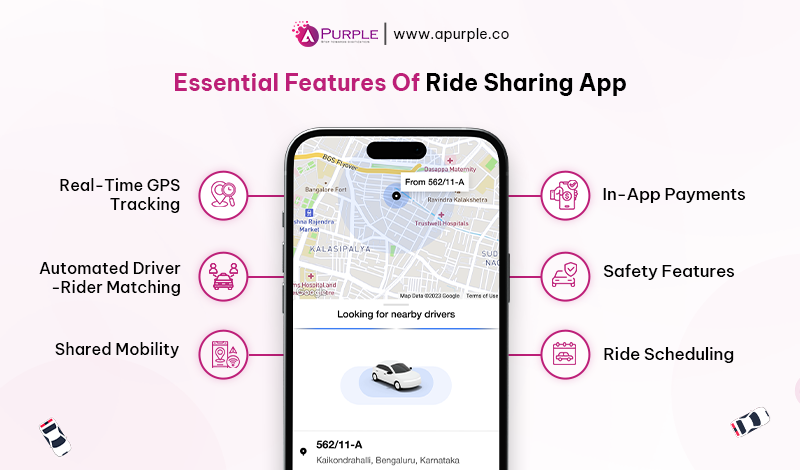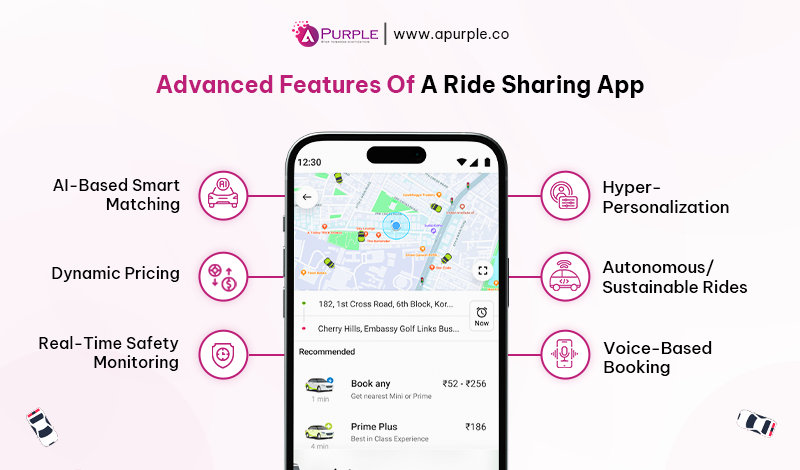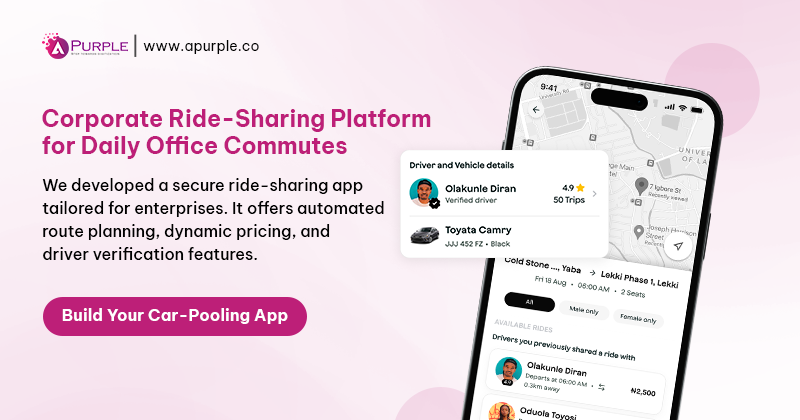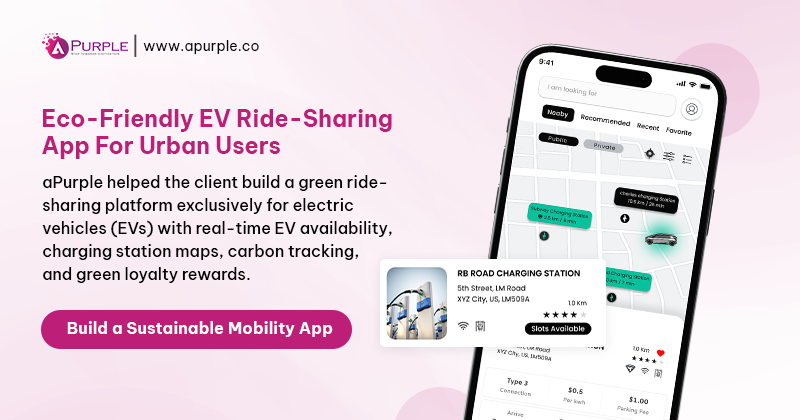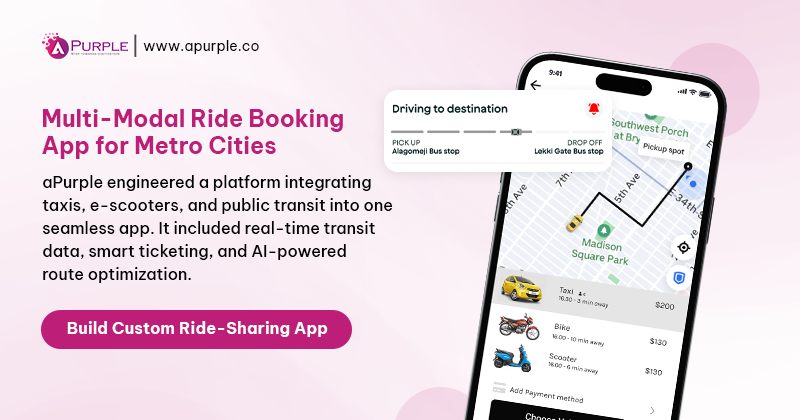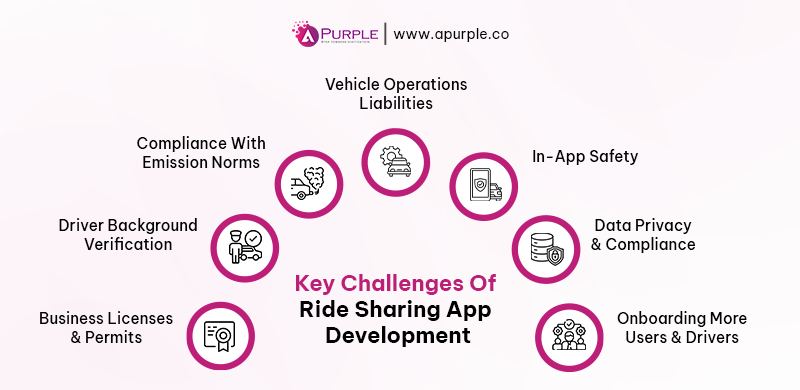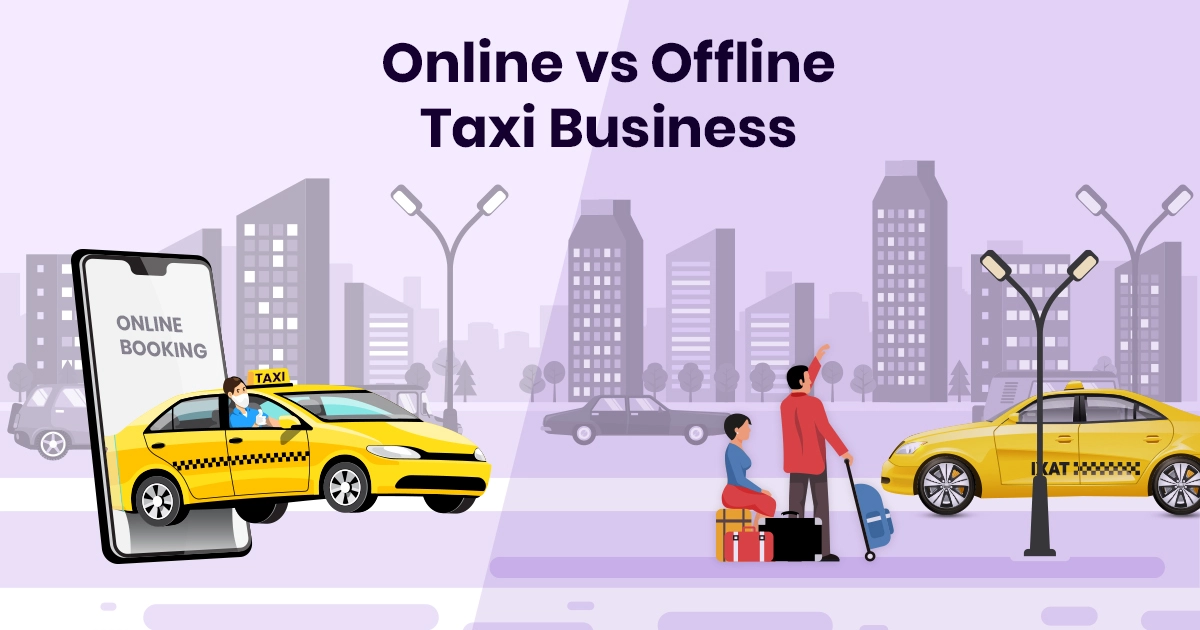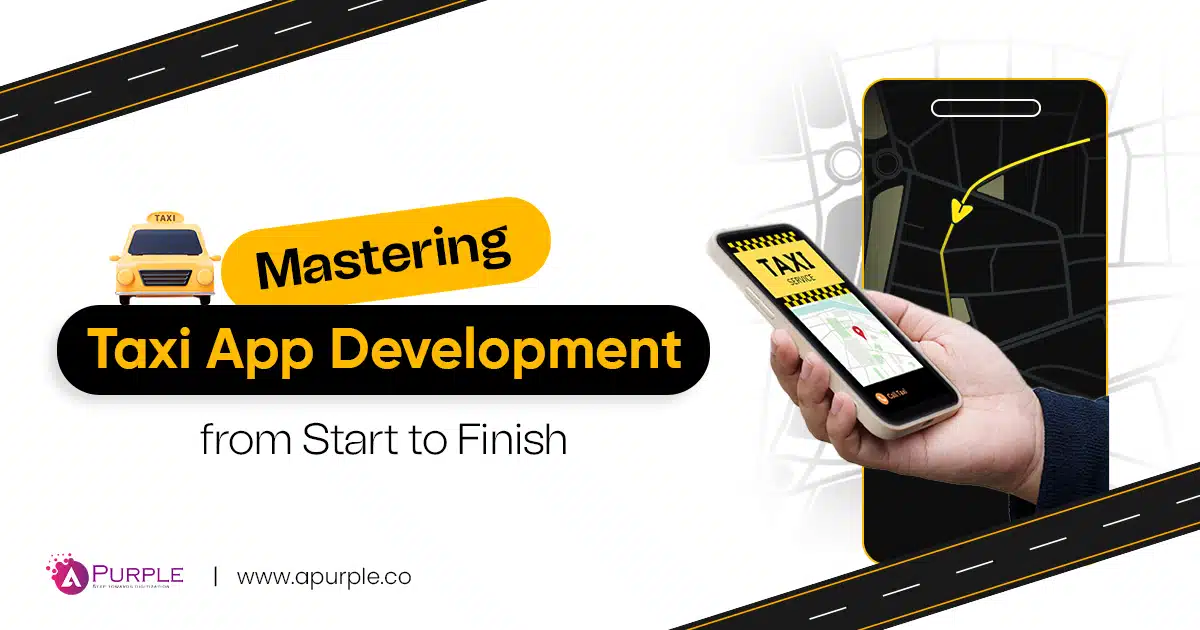
Do you have a ride-sharing app idea?
And don’t know where to start?
You are not alone. Many entrepreneurs struggle to build an app strategically to compete against market leaders like Uber or Lyft. Most founders spend six to twelve months in the planning phase, researching features, debating business models, and trying to figure out the ‘perfect’ launch strategy. Meanwhile, their market opportunity slips away to existing players or new competitors who move faster.
Aiming for perfection is not bad, but first, you need to build small and gradually make improvements. So, if you want to avoid the startup mistake of waiting to achieve a perfect launch strategy and ensure faster ride sharing app development, this guide is for you. It is a blueprint that covers everything from how to create a rideshare app to its business models, revenue streams, features, and tech stack.
Let’s start by first understanding what is rideshare app and why you need it.
What Is a Rideshare App Development?
Rideshare app development is the process of building a digital platform that connects passengers needing transportation with drivers who offer rides. Unlike traditional taxi services, rideshare apps enable independent drivers to either accept or reject rides, and riders have the option of booking a ride and making online payments.
Different types of ride-sharing apps are,
- Ride-sharing apps that match drivers with riders for a one-way trip.
- Car pooling apps where passengers share a ride and split the fare.
- Peer-to-peer rental apps, where car owners rent out their vehicles to users.
As an entrepreneur, ride-sharing app development allows you to cater to the unique needs of riders with each ride. This means a larger user base, more drivers onboarding your app, and a successful venture. However, this is not the only reason!
Why Invest In Ride-Sharing App Development?
Ride sharing app development is worth investing in because it has a rapidly growing market, high revenue potential, and ease of scalability.
- The global ride-sharing apps market size is expected to reach $138 billion by 2034, growing at a CAGR of 12.7%
- Uber is one of the most popular ride-sharing services globally, with 156 million monthly active users.
- North America leads the market, with a regional market size of $82.20 billion in 2024. This market is projected to grow at a CAGR of 18.61% by 2034.
Besides profitability, ride-sharing apps offer a higher value proposition for existing taxi businesses. So, if you are an entrepreneur looking to start a ride-sharing startup, you can even partner with taxi businesses.
This can reduce the infrastructure cost and increase profitability. Once you decide on building a car-pooling app, the next question will be, “how to make a rideshare app?”
How To Build A Rideshare App: A Step-by-Step Process
Developing a ridesharing app involves multiple steps, like conducting in-depth market research, choosing the right business model, identifying features, designing, developing, testing, and launching.
Let’s understand each step of ride sharing app development thoroughly,
Step 1: Research The Ride-Sharing App Market
Market research is crucial to your ride-sharing app development project. It offers insights into customer segments, competitors, trends, and market opportunities.
Here is how you can conduct a thorough market research.
- Use AI tools to scan competitor apps automatically, their features, pricing, and user reviews.
- Define your target audience by analyzing the ones popular apps like Uber and Lyft are targeting.
- Conduct dialogues with your target audience on Reddit, Instagram, and other social media apps.
- Use customized AI tools to process large volumes of online data from news forums, social media, and other sources.
- Segment customers based on smart profiling using AI-powered survey platforms.
- Create a landing page for your ride-sharing app to understand the market demand.
Pro Tip: Combine automated AI analysis with hands-on dialogue with your target audience. Let AI do the heavy lifting of data collection and pattern recognition while you validate findings with real users.
Step 2: Choose The Right Business And Revenue Model
Choosing the right business and revenue model is crucial because it can impact how your ride-sharing app startup shapes. 42% of startups fail because founders build solutions that customers don’t need. This is where a business model comes into play.
With the right model, you ensure the problem statement is clearly defined and the solution caters to the customer’s needs. When choosing a ridesharing app business model, you must consider different aspects, such as the target audience, market demand, competition, and legal regulations.
Here are some of the business models that you can choose from,
| Business Model | Description | Advantages | Disadvantages | Examples |
|---|---|---|---|---|
| Peer-to-Peer (P2P) Marketplace | Using this business model, you can connect independent drivers with riders via a platform. | You do not own the vehicles, making this asset-light and scalable. | Highly competitive market | Uber, Lyft |
| Premium And Luxury Services | You can offer high vehicle options and a better ride experience | You can get higher margins per ride and attract a niche, high-spending customer base. | Limited market size | Uber Black |
| Super App Integration | Expanding beyond rides to these services integrates ride-sharing services with lifestyle offerings, fintech services, and grocery delivery. | You can diversify the revenue streams for higher cash flow. | Complex operations and logistics | Gojek |
| Freight Delivery Services | You can leverage existing infrastructure to provide on-demand food delivery and freight transportation services. | You can maximize the use of resources | Higher last-mile delivery complexities | UberEats |
A business model alone is insufficient; you need a revenue model offering regular cash flow. Here are some revenue models you can choose for your ride sharing app development process.
| Revenue Models | Description | Advantages | Disadvantages | Examples |
|---|---|---|---|---|
| Commission-Based Model | The startup takes a percentage of the ride fees as commission for each ride. This is charged to the driver, passenger, or both. | Aligned incentives between platforms and drivers | Revenues depend on high transaction volume | Uber, Lyft |
| Surge Pricing | Dynamic pricing increases ride fares during periods when there is high demand | Maximizes the revenue during peak time | Can impact demand due to high prices | Uber, Lyft, and Didi |
| Subscription Model | Startups charge monthly or annual subscriptions and offer special perks and benefits for users, such as priority pickups, discounts, and longer cancellation windows. | Ensures predictable revenue | Revenue depends on how many subscriptions are active | Uber Pass, Lyft Pink |
| In-App Advertising | Ride-sharing apps can display ads from third-party providers to generate additional income for entrepreneurs. | Additional revenue streams | Can impact user experience | Uber, Lyft |
| Partnerships And Collaborations | Ride-sharing platforms often collaborate with other businesses to offer bundled services and promotional offers that improve the ride experience. | Improves user experience and offers new revenue opportunities | There are management complexities. | Uber, Lyft, BlaBlaCar, and Waymo |
Once you define the business models, identify the features that your ride-sharing app will need to meet customer expectations.
Pro Tip: Start with one monetization strategy during the MVP stage and test its viability. Later, use user feedback and analytics to refine or expand models.
Step 3- Design The UI/UX Wireframes And Prototypes
Create a wireframe of the entire user journey while booking a ride on your ride-sharing app. This will help you define specific digital touchpoints where users interact and transform the selected business model into a tangible user experience. Based on the wireframe, create interactive prototypes to understand how apps respond to specific user queries.
Here are some tips for designing UI/UX wireframes and prototypes,
- Map the user journey, visualizing the user’s path from first interaction to the payment process.
- Use annotations, maintain visual hierarchy, and keep the design simple
- Make sure the design follows usability norms with a clear call-to-action.
- Test your interactive prototypes and share results with the stakeholders.
In addition to the above tips, optimize the design of the ride-sharing app’s UI for improved micro-interactions. This will help you make the UI design more interactive and user-friendly.
Pro Tip: Ensure hyper-personalization in your ride-sharing app design by adding interactive AI-based recommendations for favorite destinations, ride types, or payment methods.
Step 4- Select Development Approach and Team
To create your own rideshare app, you can use development approaches like native, cross-platform, and hybrid app development. Here is how you can use these approaches for car-sharing app development
Native app development lets you create your own rideshare app separately for iOS and Android platforms. This approach offers seamless native performance for your apps, ensuring optimal performance. Plus, users get full access to all the device’s native features, making ride-sharing app usage seamless.
Leverage cross-platform development to save on development costs. It allows you to use the same code across iOS and Android. So, you don’t need to create two separate apps.
Using this development approach, you can create a rideshare app using web technologies wrapped in a native container. It merges web and mobile technologies to provide faster ride sharing app development.
You can choose a development approach based on specific business goals. However, you need a team with technical expertise to optimize ride sharing app development using these approaches. This is where aPurple can help you with expert taxi app development services tailored for high-performance ride-sharing platforms.
Pro Tip: Compare your choice by asking: “Will my users need top-notch performance or rapid updates?” Based on the answer, choose native for performance and cross-platform for speed and budget.
Step 5- Develop A Minimum Viable Product(MVP)
Build MVPs to let your users access a leaner version of the ride-sharing app, leveraging lean startup methodology. This will help you fine-tune app performance and features based on customer feedback. You can use MVP development services and agile methodologies for incremental improvements. With agile + lean methods, you can continuously improve your ride-sharing app and enhance user experience.
Pro Tip: Use your customers as co-creators and fine-tune features to ensure the ride sharing app development process closely aligns with their preferences.
Step 6- Test Your Ride-Sharing Apps
Testing your ride-sharing app requires a strategic approach to ensure high reliability and security. Here is how you can test your apps and ensure optimal quality assurance.
- Create a detailed test plan with a strategy outline, resources, timelines, and scope.
- Analyze the ride-sharing app requirements and design test cases to cover all scenarios.
- Implement test cases using automated testing tools like Selenium and others.
- Analyze the test results using AI-driven tools for smart insights.
- Communicate the issues with the development team
- Resolve them with complete documentation.
- Test the app for extensive data security issues.
- Make sure the app complies with data standards like GDPR and PCI DSS.
Pro Tip: Leverage generative AI models to customize test cases for your ride sharing app software development and ensure they mimic real-world scenarios during the testing phase.
Step 7- Launching The App And Maintenance
Launching your ride-sharing application includes optimizing it for app stores. You must also market the app to gain early traction from the target users across social media and other platforms. Leverage branding services to ensure efficient app marketing.
Deploy the apps across platforms and track performance through effective monitoring. Maintain the performance of ride-sharing applications to ensure an optimal user experience.
Pro Tip: Ensure the app meets the app store guidelines before submitting it for publishing on the platform. Consult with startup experts who can help you prepare the apps for app store submissions.
What Are The Key Features Of A Ride-Sharing App?
Key features of a ride-sharing app include real-time ride tracking, automated driver-rider matching, and in-app payments. The complexity of these features impacts your ride sharing app development process, so understanding each makes sense.
- Real-Time GPS Tracking– Allows users to track their rides and drivers to track the location of pickups and drop-offs.
- Automated Driver– Rider Matching- Algorithms connect riders with drivers available nearest to their location, considering ratings and vehicle preference.
- Shared Mobility– Enables riders who share the ride to split fare and adjust routes in real time to save the total cost of rides.
- In-App Payments– Offers multiple payment options, including credit cards, debit cards, digital wallets, and cryptocurrency payments.
- Ride History– Provides users access to the past ride booking history and all dispute resolution communications.
- Safety Features– Enables users to access SOS buttons in case of emergencies, driver verification, and other communication features.
- Ride Scheduling– Allows users to book rides in advance and choose a specific location for pickup and drop-off.
- Push Notifications– Enables targeted messages for users on their app that provide information on ride status, promotions, and safety alerts.
- Ratings and Reviews– This feature allows users to review and rate driver behavior and provide feedback on the overall ride experience.
These are the features you must consider for your ride sharing app development process. However, you can add smart features with technological advancements and integrate innovations like artificial intelligence.
- AI-Based Smart Matching– Uses AI to predict demand, allocate drivers automatically, and personalize ride recommendations.
- Dynamic Pricing– Enables you to adjust fares based on specific customers, peak demand, vehicle preference, and location.
- Real-Time Safety Monitoring– AI algorithms detect anomalies in operations like sudden driver route deviations or stops, triggering rider safety risks.
- Hyper-Personalization– Offers custom ride experiences for users based on their preferences for vehicle types, pet-friendly options, or quiet rides.
- Autonomous/Sustainable Rides– Integrates EV-only options, provides information on the location of nearest charging stations, tracks the carbon footprint of each ride, and has options to choose autonomous rides.
- Voice-Based Booking– Allows users to book rides using voice commands and conversational AI algorithms for an improved ride experience.
- Multi-Modal Journey Planning– Enables users to book multiple rides along their journeys, such as shared rides, public transport, and scooter rentals, for seamless door-to-door mobility.
Using these features, you can build apps that compete with ride sharing companies like Uber. Many startups successfully enter the market with Uber alternatives, offering localized innovations, safety-first features, and sustainability options.
At aPurple, we have helped many startups with advanced features and robust ride-sharing app development solutions.
Here are some of the best ride-sharing apps we built
Apart from the above apps, we’ve also worked on projects like a taxi booking app, which focused on real-time routing, secure payments, and a seamless user experience for Southeast Asian markets. Now that you have decided what features to include and understand how to make a rideshare app, it’s time to determine what technologies you will need to build it.
What Is The Tech Stack Needed For Ride Sharing App Development?
Rideshare app development requires a technology stack that offers flexibility, scalability, and ensures a seamless user experience. Some of the key tech stacks that you can use for ride sharing app development are,
| Category | Technologies/Frameworks |
|---|---|
| Frontend Development | React Native, Flutter, Swift, Kotlin |
| Backend Development | Node.js (Express.js), Python (Django/Flask), Go, Java |
| Database | MongoDB, PostgreSQL, MySQL, Redis |
| Real-time Communication | WebSockets, Socket.IO, Firebase Realtime DB, Kafka |
| Geolocation/Mapping | Google Maps API, Mapbox, HERE Maps |
| Payment Gateway | Stripe, PayPal, Braintree |
| Cloud Infrastructure | AWS, Google Cloud Platform, Azure |
Understanding the cost becomes essential now that you know which ride-sharing technologies to choose for your startup. It will help you plan the project budget more efficiently, ensuring better cash flow.
How Much Does It Cost To Build A Ride-Sharing App?
The cost of on-demand ride-sharing app development projects depends on multiple aspects, such as feature complexity, deployment platform, developer location, and third-party integration requirements. Here is the cost breakdown for ride-sharing app development based on app complexity.
| App Type | Development Approach | Estimated Cost Range |
|---|---|---|
| Basic Ride-Sharing App | Traditional | $15,000-$20,000 |
| AI-Assisted | $20,000- $25,000 | |
| Mid-Range Ride-Sharing Apps | Traditional | $25,000-$30,000 |
| AI-Assisted | $30,000-$40,000 | |
| Advanced Ride-Sharing App | Traditional | $35,000-$40,000 |
| AI-Assisted | $40,000+ |
Developing an app and running a ride-sharing platform have specific challenges. Knowing these challenges and possible solutions is crucial if you want to start a new venture and compete with the best ridesharing apps.
What Are The Key Challenges That Entrepreneurs Face While Building A Ride-Sharing Business?
An entrepreneur can face multiple hurdles while building a ride-sharing platform, from legal to operational, technological, and marketing challenges.
- You must get the necessary business licenses and permits, such as a complex Transportation Network Company (TNC) license.
- Your startup must also ensure that all drivers undergo a background check, including fingerprinting and criminal history checks.
- You must ensure all fleet vehicles meet emission norms, pass regular inspections, and are properly registered.
- Your venture will need commercial auto insurance covering all vehicle operations liabilities.
- You will need in-app safety features like SOS buttons, ride tracking, and driver verification.
- Your ride-sharing app must comply with data privacy and regulation standards like GDPR, PCI DSS, and more.
- You must market your app well to onboard more users and drivers simultaneously.
Overcoming these challenges requires ride sharing app development solutions tailored to your business requirements. For example, consulting with startup experts is essential to ensure compliance with local laws.
They will help you with strategies for optimal security and ensure compliance. Plus, you can leverage custom solutions from a ride sharing app development company to implement these strategies.
Final Thoughts
Developing a ride-sharing app can help you build a successful venture as an entrepreneur. However, it’s not a straightforward process. You have to decide on the right business model, source of revenue, features, tech stack, and strategic development plan. This is where aPurple can help you by providing strategic ride sharing app development services.
With experience in delivering more than 800 entrepreneurs, bringing their ideas to life with robust on-demand app solutions. So if you are also planning to build a ride sharing app for your venture, contact us now.
Frequently Asked Questions


